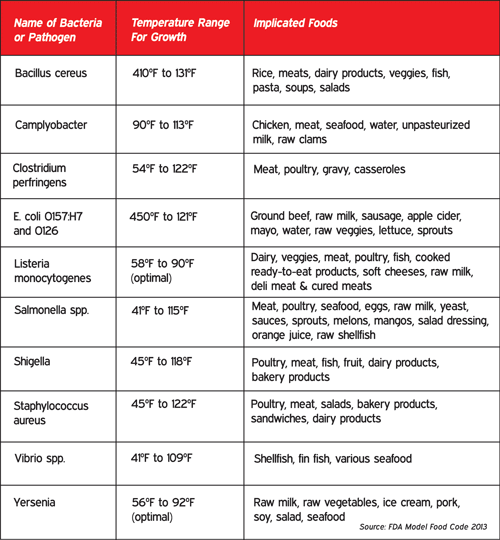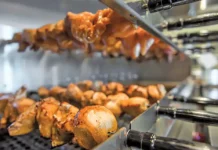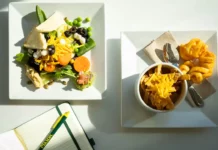
The enemy in your restaurant kitchen, I guarantee, is proper cooling.

Maybe some of your team understands, but most don’t. Of more than seven hundred inspections I’ve done in the past three years, I’ve found cooling violations in more than 70% of kitchens.
First, why proper cooling is important:
Bacteria loves the same temperatures that you & I do, and, with a little time, they multiply with gusto when they’re in the temperature Danger Zone. The Danger Zone is the range of temperatures between 140°F and 41°F. Let’s look at some common foodborne pathogens and at what temperatures they multiply at when in the Danger Zone, as shown in the chart below.
 These are not all of the foodborne pathogens that we need to be concerned about, but these do represent some widespread pathogenic bacteria that can grow easily in foods. Each of these bacteria can cause a nasty foodborne illness, leaving the consumer with diarrhea, vomiting, nausea, fever, and might even put that consumer in the hospital. Each year, one in six Americans will fall ill from food poisoning. To do your part in preventing foodborne illness, proper cooling should always be used along with proper cooking and, of course, proper cleaning & sanitizing.
These are not all of the foodborne pathogens that we need to be concerned about, but these do represent some widespread pathogenic bacteria that can grow easily in foods. Each of these bacteria can cause a nasty foodborne illness, leaving the consumer with diarrhea, vomiting, nausea, fever, and might even put that consumer in the hospital. Each year, one in six Americans will fall ill from food poisoning. To do your part in preventing foodborne illness, proper cooling should always be used along with proper cooking and, of course, proper cleaning & sanitizing.
Second, how to cool rapidly & properly:
Proper & rapid cooling will prevent pathogens from multiplying in your food and making consumers sick. The Health Code gives us a total of 6 hours to cool any potentially hazardous product, such as cooked proteins, cooked rice or pasta, cooked vegetables, etc. And we get 4 hours to cool room-temperature produce (such as tomatoes or melons) which have been cut up or processed, to 41°F or colder.
Here are the time and tools needed:
• Ice bath (you can fill a sink with ice and add water, but the ice level must be at or above the height of the product that you’re cooling)
• Ice wands or Ice paddles (these are made of food-grade plastic, and you fill them with water, then freeze them… that keeps the ice on the inside and allows you to insert the wand into the product without ice melt or mess… great for rapidly cooling soups and stocks)
• Refrigerator or freezer (product must be in shallow pans, and the product itself can’t be any deeper than 4 inches deep… that allows maximum heat transfer)
• Heat travels best through metal, so although you can cool in plastic pans or buckets, I recommend using stainless steel pans, which are proven better for heat transfer
I bet you’re wondering about “How?” and “Why?” Wonder no more! I’ve captured it in a handy list for you:
1. How: Product has finished cooking and has reached the minimum required temperature as outlined in Article 81.09(a) of the Health Code; allow to cool at outside refrigeration until product is 140°F, then you can transfer into active cooling
Why: Product at or above 140°F does not support bacterial growth.
2. How: Once the product has reached 140°F, it must be cooled rapidly, while uncovered, either inside refrigeration or in an ice bath
Why: The Health Code calls for rapid cooling from 140°F to 41°F within 6 hours. Covering the product fully slows down the release of heat, so best to leave uncovered or partially covered
3. How: Cooling must be continuous but the effectiveness of cooling is judged in two steps: First, you must reduce the temperature to 70°F within 2 hours of the product reaching 140°F. Product must be loosely covered or uncovered while it cools.
Why: Most bacteria multiply rapidly at temperatures above 70°F, so the first 2 hours of rapid cooling are extremely important. Never “nest” or stack too many products that are cooling, as this slows the heat transfer.
4. How: And the second step in the continuous cooling process is to go from 70°F to 41°F or below within an additional 4 hours, still loosely covered or uncovered.
Why: The last four hours of rapid cooling ensure that we are slowing down any bacterial outgrowth. It is important to monitor the temperature of the product with a metal stem thermometer.
5. How: Take the temperature of the product; if it is 41°F or colder, then it’s safe to cover for storage
Why: Covering the product preserves the integrity of the product while it’s being stored & also protects it from potential contamination.
And here’s one more representation of our 6 hours of total cooling time:
- From cook-to temperature to 140°F (passive cooling, on a speed rack or prep table)
- From 140°F to 70°F within 2 hours (actively cooling in ice or refrigeration)
- 70°F to 41°F or below within 4 additional hours (continues to actively cool in ice or refrigeration)
- At 41°F or below, product can be covered with a lid and stored in refrigeration or the freezer
Now let’s go chill! Keep it cool out there, team! And thanks for reading.
To learn more about how you can avoid cooling violations at your next restaurant inspection, visit Bulletproof! Food Safety’s website.
























Comments are closed.